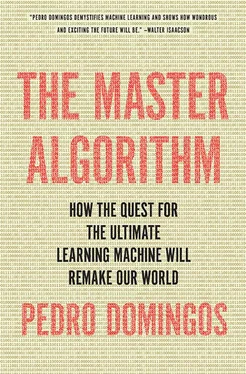Another reason researchers were initially skeptical of nearest-neighbor was that it wasn’t clear if it could learn the true borders between concepts. But in 1967 Tom Cover and Peter Hart proved that, given enough data, nearest-neighbor is at worst only twice as error-prone as the best imaginable classifier. If, say, at least 1 percent of test examples will inevitably be misclassified because of noise in the data, then nearest-neighbor is guaranteed to get at most 2 percent wrong. This was a momentous revelation. Up until then, all known classifiers assumed that the frontier had a very specific form, typically a straight line. This was a double-edged sword: on the one hand, it made proofs of correctness possible, as in the case of the perceptron, but it also meant that the classifier was strictly limited in what it could learn. Nearest-neighbor was the first algorithm in history that could take advantage of unlimited amounts of data to learn arbitrarily complex concepts. No human being could hope to trace the frontiers it forms in hyperspace from millions of examples, but because of Cover and Hart’s proof, we know that they’re probably not far off the mark. According to Ray Kurzweil, the Singularity begins when we can no longer understand what computers do. By that standard, it’s not entirely fanciful to say that it’s already under way-it began all the way back in 1951, when Fix and Hodges invented nearest-neighbor, the little algorithm that could.
The curse of dimensionality
There’s a serpent in this Eden, of course. It’s called the curse of dimensionality, and while it affects all learners to a greater or lesser degree, it’s particularly bad for nearest-neighbor. In low dimensions (like two or three), nearest-neighbor usually works quite well. But as the number of dimensions goes up, things fall apart pretty quickly. It’s not uncommon today to have thousands or even millions of attributes to learn from. For an e-commerce site trying to learn your preferences, every click you make is an attribute. So is every word on a web page, and every pixel on an image. But even with just tens or hundreds of attributes, chances are nearest-neighbor is already in trouble. The first problem is that most attributes are irrelevant: you may know a million factoids about Ken, but chances are only a few of them have anything to say about (for example) his risk of getting lung cancer. And while knowing whether he smokes is crucial for making that particular prediction, it’s probably not much help in deciding whether he’ll enjoy seeing Gravity . Symbolist methods, for one, are fairly good at disposing of irrelevant attributes. If an attribute has no information about the class, it’s just never included in the decision tree or rule set. But nearest-neighbor is hopelessly confused by irrelevant attributes because they all contribute to the similarity between examples. With enough irrelevant attributes, accidental similarity in the irrelevant dimensions swamps out meaningful similarity in the important ones, and nearest-neighbor becomes no better than random guessing.
A bigger problem is that, surprisingly, having more attributes can be harmful even when they’re all relevant. You’d think that more information is always better-isn’t that the motto of our age? But as the number of dimensions goes up, the number of training examples you need to locate the concept’s frontiers goes up exponentially. With twenty Boolean attributes, there are roughly a million different possible examples. With twenty-one, there are two million, and a corresponding number of ways the frontier could wind between them. Every extra attribute makes the learning problem twice as hard, and that’s just with Boolean attributes. If the attribute is highly informative, the benefit of adding it may exceed the cost. But if you have only weakly informative attributes, like the words in an e-mail or the pixels in an image, you’re probably in trouble, even though collectively they may have enough information to predict what you want.
It gets even worse. Nearest-neighbor is based on finding similar objects, and in high dimensions, the notion of similarity itself breaks down. Hyperspace is like the Twilight Zone. The intuitions we have from living in three dimensions no longer apply, and weird and weirder things start to happen. Consider an orange: a tasty ball of pulp surrounded by a thin shell of skin. Let’s say 90 percent of the radius of an orange is occupied by pulp, and the remaining 10 percent by skin. That means 73 percent of the volume of the orange is pulp (0.9 3). Now consider a hyperorange: still with 90 percent of the radius occupied by pulp, but in a hundred dimensions, say. The pulp has shrunk to only about three thousandths of a percent of the hyperorange’s volume (0.9 100). The hyperorange is all skin, and you’ll never be done peeling it!
Another disturbing example is what happens with our good old friend, the normal distribution, aka a bell curve. What a normal distribution says is that data is essentially located at a point (the mean of the distribution), but with some fuzz around it (given by the standard deviation). Right? Not in hyperspace. With a high-dimensional normal distribution, you’re more likely to get a sample far from the mean than close to it. A bell curve in hyperspace looks more like a doughnut than a bell. And when nearest-neighbor walks into this topsy-turvy world, it gets hopelessly confused. All examples look equally alike, and at the same time they’re too far from each other to make useful predictions. If you sprinkle examples uniformly at random inside a high-dimensional hypercube, most are closer to a face of the cube than to their nearest neighbor. In medieval maps, uncharted areas were marked with dragons, sea serpents, and other fantastical creatures, or just with the phrase here be dragons . In hyperspace, the dragons are everywhere, including at your front door. Try to walk to your next-door neighbor’s house, and you’ll never get there; you’ll be forever lost in strange lands, wondering where all the familiar things went.
Decision trees are not immune to the curse of dimensionality either. Let’s say the concept you’re trying to learn is a sphere: points inside it are positive, and points outside it are negative. A decision tree can approximate a sphere by the smallest cube it fits inside. Not perfect, but not too bad either: only the corners of the cube get misclassified. But in high dimensions, almost the entire volume of the hypercube lies outside the hypersphere. For every example you correctly classify as positive, you incorrectly classify many negative ones as positive, causing your accuracy to plummet.
In fact, no learner is immune to the curse of dimensionality. It’s the second worst problem in machine learning, after overfitting. The term curse of dimensionality was coined by Richard Bellman, a control theorist, in the fifties. He observed that control algorithms that worked fine in three dimensions became hopelessly inefficient in higher-dimensional spaces, such as when you want to control every joint in a robot arm or every knob in a chemical plant. But in machine learning the problem is more than just computational cost-it’s that learning itself becomes harder and harder as the dimensionality goes up.
All is not lost, however. The first thing we can do is get rid of the irrelevant dimensions. Decision trees do this automatically by computing the information gain of each attribute and using only the most informative ones. For nearest-neighbor, we can accomplish something similar by first discarding all attributes whose information gain is below some threshold and then measuring similarity only in the reduced space. This is quick and good enough for some applications, but unfortunately it precludes learning many concepts, like exclusive-OR: if an attribute only says something about the class when combined with others, but not on its own, it will be discarded. A more expensive but smarter option is to “wrap” the attribute selection around the learner itself, with a hill-climbing search that keeps deleting attributes as long as that doesn’t hurt nearest-neighbor’s accuracy on held-out data. Newton did a lot of attribute selection when he decided that all that matters for predicting an object’s trajectory is its mass-not its color, smell, age, or myriad other properties. In fact, the most important thing about an equation is all the quantities that don’t appear in it: once we know what the essentials are, figuring out how they depend on each other is often the easier part.
Читать дальше












